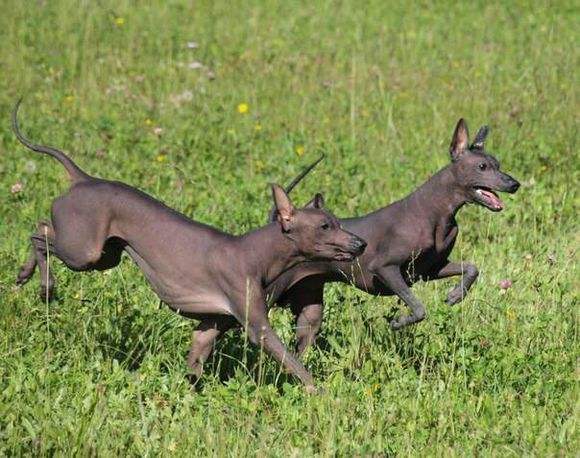Xoloitzcuintle
IUCN
LCBasic Information
Scientific classification
- name:Xoloitzcuintle
- Scientific Name:Mexican Hairless Dog, Zoroz Interli
- Outline:Carnivora
- Family:Canidae
Vital signs
- length:28-31cm
- Weight:4-8kg
- lifetime:14-20year
Feature
It is a rare hairless dog breed.
Distribution and Habitat
Native to Mexico
Appearance
The head is long and thin with a narrow skull. The ears are usually set at an angle of 50° to 80°. The eyes are slightly almond-shaped. The muzzle tapers gradually. The chest is deep and quite narrow, reaching all the way to the elbows, and the front legs are long and straight. The soft back continues all the way to the rounded tail. The feet are small, with retractable toes, just like a rabbit's feet. The tail is long, with a low position and gradually tapers to the tip of the tail. It is hairless. Because the dog's body temperature is very high, the skin feels very hot. The coat color is liver-colored short hair, blue short hair, and black short hair.
Details
The Mexican Hairless Dog is one of the earliest dogs in the world and was once used as a bed-warmer and pet, but it is not very popular. This clever, lively and affectionate animal is often compared to ancient African stray dogs and European terriers. Their physical structure is reminiscent of the classic sighthound, but their personality is very similar to that of the foxhound.

The Mexican Hairless Dog is cheerful and intelligent, gentle and self-controlled, but they are also noble animals that cannot be underestimated. When they are angered, they will roar loudly. Unlike other dogs, this dog roars "crying" instead of "barking".
The Mexican Hairless Dog is one of the earliest dogs in the world. Unlike the Chinese Crested Dog, the Mexican Hairless Dog has a sparse tuft of short hair on its head, and its body is smooth and soft. When they are puppies, they have lion noses and short legs, which is very different from adult dogs.
Hairless dogs already existed in the Mayan civilization around 1500 BC. The hairless dogs at that time were the ancestors of the current Peruvian Hairless Dogs, and were the basic dogs of the hairless dog breeds in central South America, including the Mexican Hairless Dog. Because the Mexican Hairless Dog has a high body temperature, it was once used as a bed-warming dog, to keep patients warm, to treat arthritis, etc., and was also used as food during famine. When the Spanish invaded, the number of this dog decreased significantly and even faced the danger of extinction. Thanks to the breeding of the indigenous people living in the interior, it survived extinction. In 1492, Columbus brought the Xico Hairless Dog back to Europe. In the late 19th century, the dog was gradually raised as a family dog. In 1956, it was recognized by the Mexican Kennel Club. In Europe, it is called "Zoroz Inteli Dog".
FCI divides this breed into three sub-breeds: Standard, Intermediate, and Miniature; CKC is divided into four independent breeds: Standard Xoloitzcuintli, Miniature Xoloitzcuintli, Xoloitzcuintli, and Toy Xoloitzcuintli; KC is divided into three independent breeds: Intermediate Mexican Hairless, Miniature Mexican Hairless, and Standard Mexican Hairless.
The Mexican Hairless is lively and friendly, cheerful and quiet, and is more alert to strangers. It is a lovely pet dog. It has a noble temperament and elegant posture, which is different from ordinary hounds or terriers. It needs socialization training from an early age to avoid excessive tension. It does not need too much exercise. Due to its special skin, it should pay great attention to cold protection and hygiene, pay attention to allergies to certain textiles, and keep its skin moist at all times. The glaring sun can also hurt its skin.
Protect wild animals and eliminate game.
Maintaining ecological balance is everyone's responsibility!
FAQ
What is a Mexican hairless dog?
The Mexican hairless dog, scientifically known as Xoloitzcuintli, is an ancient breed native to Mexico, famous for its hairless appearance. It is considered the national dog of Mexico.What are the physical characteristics of a Mexican hairless dog?
The Xolo comes in two varieties: hairless and coated. Hairless Xolos have smooth, exposed skin in various colors, including black, gray, and brown. They come in three sizes: toy, miniature, and standard.What is the temperament of a Mexican hairless dog?
Xolos are calm, loyal, and intelligent, making them excellent family companions. They may be wary of strangers but are affectionate toward their family members.Does a Mexican hairless dog require special care?
Yes, their exposed skin needs extra care to avoid sunburn, cold exposure, and dryness. Regular skin cleaning is essential to prevent infections or dryness.Are Mexican hairless dogs prone to genetic diseases?
Due to their unique genetics, Xolos may have dental issues, such as missing teeth. However, they are generally a healthy breed with proper care and regular veterinary check-ups.








